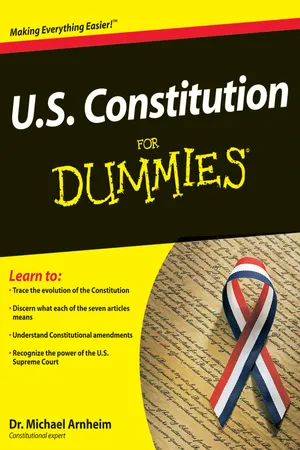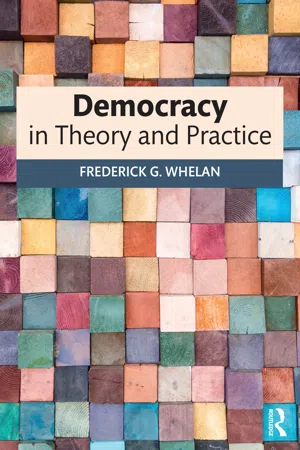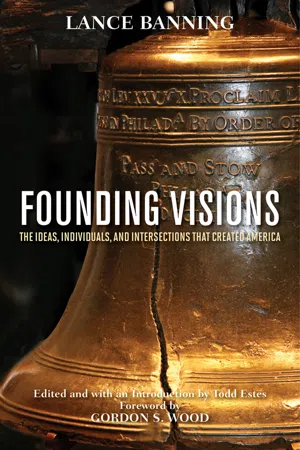History
Constitutional Convention
The Constitutional Convention was a gathering of delegates from the original 13 colonies in Philadelphia in 1787. The purpose was to revise the Articles of Confederation, but instead, the delegates drafted the United States Constitution. The convention resulted in the creation of a new framework for the American government, establishing the principles of federalism, separation of powers, and checks and balances.
Written by Perlego with AI-assistance
Related key terms
3 Key excerpts on "Constitutional Convention"
- eBook - ePub
- Michael Arnheim(Author)
- 2009(Publication Date)
- For Dummies(Publisher)
is a constitution? Okay, here goes. A constitution is a sort of super-law that regulates the way a country or state is run. How helpful is that as a definition? Not very? So let’s be more specific, and this time let’s focus specifically on the Constitution of the United States.The U.S. Constitution is the supreme law of the nation controlling the following main features (plus a few more): The functions and powers of the different branches of the government: the President, the Congress, and the courts The way in which the President and the Congress are elected and how federal judges are appointed The way government officials — including the President and the judges — can be fired The relationship between the federal government and the states Your rights as a citizen or inhabitant of the United States Knowing When and Why the Constitution Was CreatedThe Constitution emerged from a meeting called the Philadelphia Convention, which took place in 1787. (That meeting has since come to be known also as the Constitutional Convention. ) The Convention was held because the Articles of Confederation — the document that had been serving as the country’s first governing constitution — were considered to be weak and problematic (see Chapter 2). The stated goal of the Convention was to revise the Articles of Confederation, but the outcome was much more than a mere revision: It was a new form of government.The 55 delegates to the Philadelphia Convention came to be known as the Framers of the Constitution. They represented 12 of the 13 states (Rhode Island didn’t send a delegate), and they included some familiar names, such as George Washington, Alexander Hamilton, and James Madison.The Convention lasted from May 25 to September 17, 1787. In the end, only 39 of the 55 delegates actually signed the Constitution. Three delegates refused to sign it, and the rest had left the Convention before the signing took place.In order for the Constitution to take effect, it had to be ratified - eBook - ePub
- Frederick G. Whelan(Author)
- 2018(Publication Date)
- Routledge(Publisher)
In a democracy without a written constitution, notably the UK, there is no formally prescribed amending procedure. Just as the constitution consists of a somewhat amorphous body of customs and statutes of recognized importance, so constitutional change is effected by the passage of new statutes on matters of governmental form and process. For example, the Labour government under Blair (1997–2007) enacted legislation on local government devolution in Scotland and Wales, new proportional-representation electoral laws for regional elections, reduction of the hereditary component of the House of Lords, and incorporation of the European Human Rights Convention into British law–all now elements of the UK constitution.If democratic principles imply that the members of an association or polity may amend their constitution, may they not also replace it with an entirely new one? This could require the convening of a new Constitutional Convention, an option that could conceivably be provided for in the existing constitution. Once such a convention was assembled, its decisions would be held to reflect the wishes of the people as conveyed through their elected delegates, subject to eventual popular ratification; but the agenda of the convention could not be restricted; in a moment when popular sovereignty is being exercised, all questions would potentially be open.The US Constitution (Article V) provides for conventions (chosen independently of the legislatures) to propose and ratify amendments, but it does not mention the possibility of a comprehensive new Constitutional Convention. Radical alterations in the present document, however, even its entire replacement, could (legally) be accomplished piecemeal through a number of amendments that superseded the existing provisions. - eBook - ePub
Founding Visions
The Ideas, Individuals, and Intersections that Created America
- Lance Banning, Todd Estes(Authors)
- 2014(Publication Date)
- The University Press of Kentucky(Publisher)
The letters seldom probed the fundamentals of political philosophy, assuming the importance of justice, liberty, and the general welfare without defining any of these terms. For all these flaws, however, the essays were distinguishable from the beginning from the more ephemeral polemics in which others urged the ratification of the Constitution. The Constitutional Convention had devised a new and quite distinctive form of federal association, distributing between the states and the several branches of the central government powers that were to be exerted concurrently on the individuals who made up the nation. The Federalist was a vital contribution to the explanation and defense of this new concept, which they helped to name. They explained why the Convention had divided powers as it did and sometimes justified or rendered more coherent decisions that the Framers made for reasons that were only partly theoretical. In doing so, they remolded and permanently revised several of the central concepts of modern constitutionalism: separation of powers, checks and balances, executive responsibility, and organic law, as well as division of authority between the federal government and the states. In the end, the letters also redefined the revolutionary ideal of a free and stable democratic order, much as their authors thought the original Publics had done for ancient Rome. In the United States and in all the modern federal republics that have been influenced by the American example, those who wish to understand these great ideas must turn, at minimum, to essays 1, 2, 9, 10, 14, 15, 17, 23, 37, 39, 47–51, 62–63, 70, 78, 84, and 85. Bibliography Primary Sources. Jacob E. Cooke, ed., The Federalist (Middletown, Conn., 1961), is the definitive scholarly edition of the text. Cooke’s preface and footnotes offer precise information about publication and a superb summary discussion of the scholarly controversy over the authorship of disputed essays. Roy P
Learn about this page
Index pages curate the most relevant extracts from our library of academic textbooks. They’ve been created using an in-house natural language model (NLM), each adding context and meaning to key research topics.


